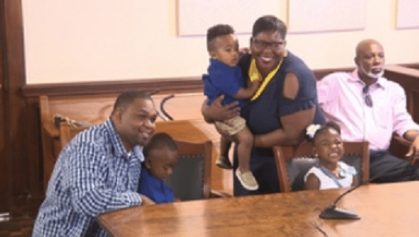It’s a menu unlike any other. Or, paradoxically, it’s a menu too much like any other, where economics determines the value of the listed commodities.
Except these are not commodities, these are children. And they are in need of a home.
The menu relays their value. For an African-American baby, you’ll likely spend about $17,000 and, for a young African-American girl, you’ll pay the same. If that doesn’t quite work for you, and you prefer a biracial baby of either gender or a biracial girl, the cost will commonly climb all the way up to $25,000.
However, if you aspire to claim the American adoption system’s most prized possessions — a biracial male preschooler or a Caucasian newborn — you’ll cough up a whopping $30,000 for your discerning taste, given these valuable human trophies don’t come cheap.
“As a Black person, it’s totally offensive,” says Jacquelynn Moffett, president of Homes for Black Children in Detroit. Founded in 1969 in the aftermath of the 1967 Detroit rebellions — and as the first specialized African-American adoption agency in the nation — Homes for Black Children has since committed itself to locating permanent homes for the many African-American children who still languish in the foster care system.
After noting such a racially-skewed adoption menu “looks like a slave poster,” Moffett moves beyond her personal feelings to address the harsh realities of her industry. “From a service point of view, I think it really speaks to how adoption services are funded,” says Moffett, detailing the difference between state-funded and private adoption services. The former relies upon government subsidies to find homes for those in the state’s child welfare system due to abuse, neglect or abandonment, and ranging from toddlers to age 21, given efforts at reunifying them with their birth parents have failed. The latter is fueled by the paid fees — placement charge plus administrative costs — of families who can afford the process and typically involves a birth mother planning an adoption for her yet-to-be-born baby where she voluntarily relinquishes her parental rights. In such private adoptions agencies profit from these transactions, while they also commonly contract with the state to place older children selected from the state pool. With public adoption, there is no profit motive as the state looks outward to place children, often with special needs, in homes. With private adoption, there is a profit motive as agencies look inward at the state pool to select adoptees. Consistently, parents willing to pay privately have more choice than those adopting through the state foster care system.
With this two-tiered system, Moffett says many Black families “simply don’t have the resources to adopt privately because they don’t earn that kind of money,” facilitating an inequitable private process where harder-to-place children cost less to acquire. She acknowledges it’s “a mixed bag, because I am not supporting that I want them in that system. But it’s totally insulting.”
Moffett expresses such ambivalence about a pricing system that has been created at least in part as a well-meant attempt to address a larger societal problem. In America, white and biracial babies and children are in demand more than their African-American counterparts. Of the estimated 430,000 children in foster care, a quarter of them are Black. Given that these children are harder to place, the cost is commonly adjusted to incentivize families — both African-Americans and other parents considering cross-racial adoption — who otherwise might not be able to privately adopt.
“I have no problem with a white family adopting Black children because I’d rather have that than them growing up in foster care,” offers Tommy Lee Hayes-Brown, a corporate executive in Charlotte, N.C. He and his wife, Sharon, a fellow Howard University alum, are the proud parents of three adopted children and a biological child. As far back as college, even before they were romantically involved, they shared a desire to one day open their homes to a child in need of one. Their successful adoption story was first covered by the Discovery Channel in 2003.
Although Hayes-Brown is supportive of African-American children being adopted by parents of any race or sexuality as long as those parents can provide them a loving home, he clarifies his position. “Ideally, it’s better for a Black child to be raised in a Black home,” he says, noting, “There’s just cultural aspects, ways of life and traditions that are going to be passed to that child that align with who they are, that are wired within their DNA, that can be supported by having a Black mother and father.” While a white family, continues Hayes-Brown, can work to supply some of that, “It’s just easier when it’s a part of who you already are.”
“Our concern has been that it is important for African-American families to have the opportunity to adopt children within their own community because one of the things agencies can traditionally do is set the standards in such a way that are unfavorable,” says Moffett, be that “through accessibility, location, hours, fees or other established barriers to adopt.” After noting the core question for parents of any race is “can you love a child that you didn’t give birth to?” she stresses her agency’s commitment to getting Black families “the same level of service as any other ethnic group would have.” Moffett says within the current system the ideal would be to include the same level of affordable fees for all children acquired through private agencies.
That said, Moffett agrees with Hayes-Brown. “I think there are infinite advantages for children being around people who look like them and know their cultural heritage.”
The history and heritage of her own agency and its 1969 founding largely parallel the plight of African-American adoption in America. Prior to the creation of Homes for Black Children, child welfare agencies customarily placed Black children entering the child welfare system into long-term foster care without publicizing their presence to potential adoptive parents. Institutional racism and discrimination by traditional agencies factored into the process. “At that point in history, people basically didn’t think that Black families would come forth to adopt African-American children, but we knew from our own experience in our community that this wasn’t so,” Moffett said. “African-Americans had traditionally adopted informally, and had not gone through agencies, but have always been people who care for children not born to us. So armed with that knowledge, we just simply let the community know that the children were waiting and, in that first year, we placed more children than all of the 14 local agencies combined.”
Moffett’s account describes the success of Homes for Black Children continuing to become a model and what she called “a vehicle for changing adoption policy throughout the United States.”
Over the ensuing decades, a number of specialized agencies led by African-Americans were established to find much-needed placements for Black children, including Another Choice for Black Children in Charlotte, where Hayes-Brown adopted his three boys. Given his successful interaction with the nontraditional agency, and the resulting and awe-inspiring love story of his close-knit family, Hayes-Brown was dismayed to learn of how some traditional private agencies choose to price their children by race.
“The last time I checked, the most desirable child was a white female,” says Hayes-Brown, noting “my children are at the bottom of the barrel when it comes to being desired by the overall population.” The corporate executive acknowledges such cost structures are likely due to “supply and demand, just like any other business.” Still, he adds, “It’s kind of disheartening. It really is.”
Moffett suggests a less disheartening alternative to private agency fee structures. “I think it would be a great movement for there to be funding for these services so it’s not a question of which child comes to the front of the line or which family has the money to pay an adoption service.” If it were a publicly funded process, she says, “That would just tear the legs out from under [the current private system] and the fact that people can profit off of it.”
Ultimately, such a movement would lead to a day where Moffett would not have to recoil at the site of racially-tiered adoption menus that devalue African-American children.
“As a private citizen, I’m appalled by it,” reiterates Moffett. “From a social work community perspective, there just has to be a better way to fund adoption services so it’s more equal all around.”


